Explainer
- Explainer
- Trade wars
Trade war: what is going on in the world's trading system?
Eighteen months since the "trade war" began, it is hotter than ever. Who started it? How has it played out so far? And even if there is a truce, will this help or hinder Australia?
By Matt Wade
It started as a skirmish but has escalated into full-blown war. The trade conflict between the US and China has sent the world’s financial markets into a funk, raised fears of global recession and cast doubt on the rules-based trading system built up over decades.
Australia is one of many nations caught in the crossfire as the stoush erodes investor confidence and drags on growth. And there are warnings the trade feud will permanently change the dynamics of global trade whatever happens.
Tensions escalated dramatically in August but US President Donald Trump raised hopes of a truce at last weekend’s G7 summit when he said negotiations would resume “very shortly”. Then, a few days later, he confirmed that the next round of tariffs – a key weapon in the trade war – would begin nonetheless.
But even if Washington and Beijing do strike a deal, what will it contain? And will it help or hinder Australia?
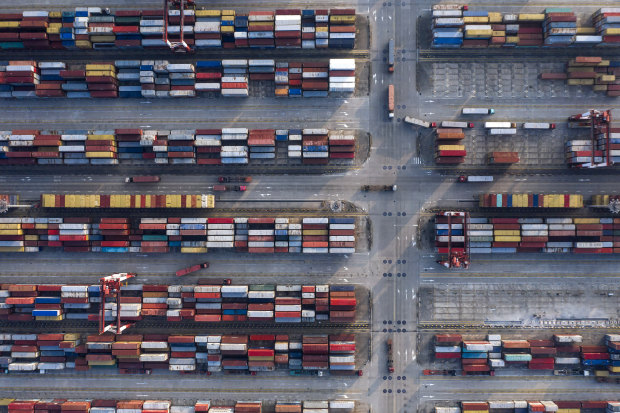
Cranes and containers at Yangshan Deepwater port in Shanghai in August.Credit: Bloomberg
What is the trade war?
It all started in January last year, when Trump announced new tariffs on the import of solar panels and washing machines made in China. A tariff is a tax imposed on a good or service as it's imported into a country. Their main purpose, in a modern economy, is to increase the price of imports in order to protect local producers from foreign competition.
Trump, whose electoral pitch was to put “America First”, claims many countries, especially China, have been taking advantage of the US when it comes to trade.
Trade tensions are taking a toll and global growth is projected to slow.
Laurence Boone, chief economist of the Organisation for Economic Cooperation and Development
US Commerce Department figures show that the US purchased $US419 billion ($622 billion) more from China than they sold to it last year. Trump claims that gap – called a trade deficit – is evidence of unfairness, although many economists argue that’s the wrong way to look at it.
In March 2018, Trump increased tariffs on steel imports from China and a host of other countries and declared on Twitter that trade wars are “good and easy to win”.
China retaliated with tariffs of its own and a spate of tit-for-tat tariff hikes followed.
It has only escalated from there. Virtually every commodity imported to the US from China will, by next year, be hit with an extra tariff. The list is 530 pages long. Many of the tariffs imposed by China in retaliation have deliberately targeted agricultural exports important in states where Trump is popular, such as soybeans. Beijing has pledged to take “necessary countermeasures” to changes in US trade policy.
There are exemptions, of course. Trump is not charging a tariff on bibles and other religious texts imported from China after Christian groups argued that would infringe on religious freedom, ProPublica reports. Chemicals used in fracking also escaped tariffs after the oil and gas industry argued that taxing them would threaten America’s “energy dominance”.
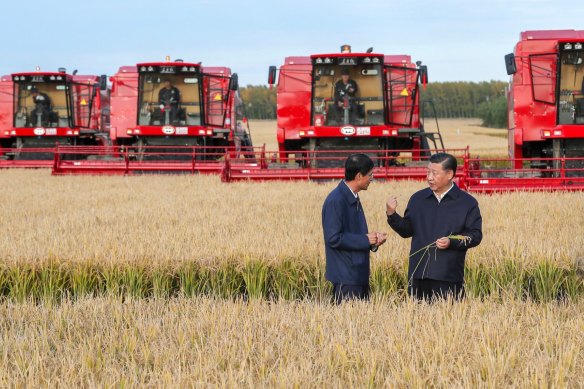
Chinese President Xi Jinping, right, visits a farm in Jiansanjiang in 2018.Credit: Xinhua/AP
Trump, who dubbed himself Tariff Man in December, incorrectly claims China is paying the tariffs for the “privilege” of trading with the US. This is not how tariffs work. Rather, it is US importers who pay these trade taxes when the products arrive at the US border. Some firms choose to absorb that cost and make less money, others pass on the price increase to consumers.
In June, the International Monetary Fund estimated tariff increases imposed by the US and China would reduce global GDP by 0.5 per cent next year, which amounts to a loss of $US455 billion ($646 billion). The outgoing head of the fund, Christine Lagarde, labelled the trade conflict “self-inflicted wounds”.
After months on simmer, the trade war became white-hot in August with a fresh exchange of tariff increases. When the latest round announced by Trump comes into effect, nearly everything China exports to the US will be taxed, from iPhones to handbags.
Trade specialist Tim Harcourt says many experts have been “caught out” by Trump’s determination to follow through on his trade agenda. “We thought he’d just tweet a few things and maybe get one major company to stay in Ohio or Wisconsin and he’d be done,” says Harcourt, the J.W. Neville Fellow in Economics at the University of New South Wales. “But we’ve got a shock because he really did want to change things.”
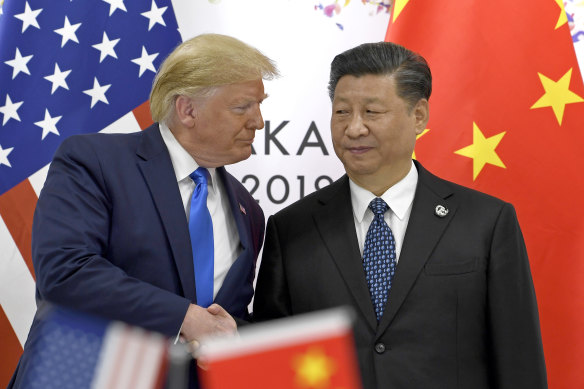
Donald Trump and Xi Jinping during the G20 summit in Japan in June.Credit: AP
Why is a trade war between two nations causing turmoil everywhere?
Trade disputes are common but this one, involving the world’s two biggest economies, is the most serious in decades. The erratic nature of the dispute, with tariff hikes announced out of the blue by Trump on Twitter, has created huge uncertainty for investors, businesses and consumers worldwide.
"It's impossible for businesses to plan for the future in this type of environment,” said David French from the US National Retail Federation after Trump announced another tariff hike on August 23.
The trade war has also cast a shadow over international supply chains, which rely increasingly on bringing components from a number of different jurisdictions. Without timely and low-cost delivery of parts, the manufacture and distribution of products ranging from cars and aeroplanes to electronics could be interrupted.
Aggressive trade tactics have caused tumult in global financial markets as well, as investors retreat to safe havens. Reserve Bank deputy governor Guy Debelle says businesses are likely to delay major investments because of this uncertainty.
“It is too risky to commit to a multi-year project or buy a large piece of plant if the economics of the decision can get completely undermined by a policy decision,” he said.
Consumers might also put off purchases amid the confusion. Delayed business investment and less consumer spending will eventually slow the economy and reduce employment.
On August 24, Trump instructed US firms to quit China entirely, raising the spectre of a disruptive, long-term “decoupling” of the US and Chinese economies. Even if Trump loses re-election in 2020, some experts warn the global trading system will not be the same.
Did Trump alone cause the trade war?
US-China trade tensions pre-date this presidency. In the decade before Trump's election, the US government lodged a host of complaints about China’s trade practices at the World Trade Organisation (WTO), the body that oversees the rules of international trade. Their objections included China's intellectual property breaches and its subsidies to agriculture as well as grants, loans and other incentives which advantaged Chinese exporters.
The Trump administration believes the WTO failed to address China’s “unfair” trade practices. He has opted for a different tack and claimed his trade war with China should have started years ago. “Somebody had to do it. I am the Chosen One,” he said on August 21.
But the trade tussle also comes at a time of transition in the world economy. The world’s fifth-biggest economy, Britain, is breaking from the European Union, the world’s biggest free-trade bloc, and is on the lookout for new partners. Powerful economic forces, especially technological change, are also altering the nature of globalisation.
Trade in services, such as tourism and education, is now growing faster than trade in goods, transforming the character of cross-border exchange. Meanwhile, more goods are being consumed within the country that produced them and that means a smaller share is being exported.
A recent report by the McKinsey Global Institute showed a larger share of trade is taking place within regional blocs, especially Asia and Europe, as opposed to trade between more far-flung buyers and sellers. The rapid economic growth of developing nations, particularly China, has been a key driver of these changes, as consumers in those nations now buy more of what their own countries produce.
“Lower global trade intensity is a sign that these countries are reaching the next stage of economic development,” says the McKinsey report.
The post-World War II process of globalisation driven by multilateral agreements that allowed ever-increasing trade openness is being challenged.
Laurence Boone, chief economist of the Organisation for Economic Cooperation and Development
At the same time, there has been a widespread political backlash against some of the effects of trade liberalisation. Globalisation has been blamed for destroying manufacturing jobs in advanced economies and for undermining distinctive lifestyles and cultures.
The trend of the past 40 years has been towards lower trade barriers but the pendulum now seems to be swinging in the other direction. Australia’s Productivity Commission said in June the world’s rules-based trading system was “under greater strain” than at any time since the 1930s.
“Protectionist sentiment is once again on the rise around the world,” said the commission’s chair, Michael Brennan. “Unfortunately, we are seeing the language of market gain give way to the language of strategic rivalry, resulting in unpredictable trade policy. This is bad for business and bad for jobs.”
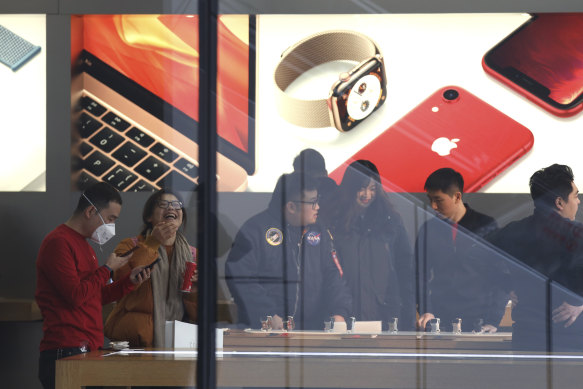
Customers at an Apple store in Beijing, where sales have slowed due to consumer anxiety over the trade war.Credit: AP
How does technology fit into the trade war?
The trade war has been complicated by a high-stakes battle over technology. The US says Chinese firms adopt unfair tactics in their dealings with US tech companies, with Beijing’s backing. This includes firms being forced to hand over their know-how if they want to do business in China. Trump claims China has “stolen” intellectual property worth “hundreds of billions of dollars” from the US, adding: “We don't need China.”
The tech-related tensions intensified in May when the Trump administration slapped restrictions on US firms trading with Chinese technology giant Huawei, on the grounds of national security.
Debelle says the damage caused by the US-China technology dispute could be even bigger than that of the tariff war. “The technology dispute raises the possibility that any business involved in the technology production chain will have to choose between East and West rather than selling into a global market,” he said in August.
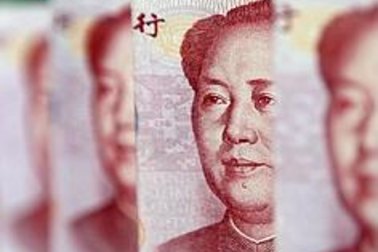
Mao Zedong’s face on remnimbi notes.Credit: Reuters
What about currency manipulation? Is that part of it?
Another new front in the commercial conflict between Washington and Beijing flared in August, when the US Treasury Department formally declared China a “currency manipulator”. It is the first time in 25 years that the US has done that to any country. It came as the Chinese currency, the renminbi, dropped below the symbolic threshold of ¥7 to the US dollar for the first time since 2008.
The US has long accused China of keeping the renminbi artificially low to make its exports more competitive.
A weaker currency means Chinese products are cheaper in American dollars, which makes them more competitive and therefore more attractive to consumers. This can help compensate for the tariffs (by absorbing some or all of the extra tax), and allow Chinese exporters to continue to out-compete American manufacturers on price.
While declaring China a currency manipulator was a largely symbolic move by the Trump administration, it underscored how strained relations between the world’s two largest economies have become and introduced a new element of uncertainty for investors.
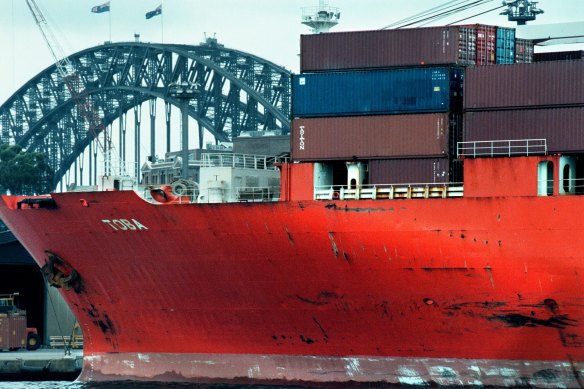
Where does Australia stand in the trade war?Credit: Patrick Cummins
How much do Australia and the world rely on trade?
The '90s and the noughties marked a golden era of globalisation and trade growth. The value of trade reached a record 61 per cent of global GDP in 2008, up from just 39 per cent in 1990. And the trade boom contributed to a worldwide surge in living standards, especially in developing countries.
“International trade has proved to be one of the greatest anti-poverty programs ever, nowhere more so than in Asia,” said Harcourt.
Australia has become deeply integrated into the global economy over the past three decades, so much so that one in five of our workers is now involved in trade-related activities. We rank 55th in the world for population but we’re the 23rd-largest exporter and 21st-largest importer. Trade has underpinned a striking Australian achievement – more than a quarter of a century of uninterrupted economic expansion.
Australia is …
- the world’s largest exporter of iron ore, coal, unwrought lead and wool
- the 2nd largest exporter of aluminium ores, beef, lentils and cotton
- the 3rd largest provider of international education services
- the 4th largest global exporter of liquefied natural gas
- the 5th largest exporter of wine
Trade allows Australia to earn income from agricultural and mining commodities which are far too plentiful for us to consume ourselves. Australia exports about two-thirds of its agricultural produce, from wheat to wool, as well as around 95 per cent of its iron ore and almost all metallurgical coal production – the coal that’s used for steelmaking.
What effect will the trade war have on Australia?
The trade conflict is a major threat to the Australian economy. However, some industry sectors are benefiting, at least in the short term. For instance, the price of iron ore – one of Australia’s biggest exports – has been pushed up recently because the Chinese government has sought to offset the domestic impact of the trade war by stimulating its economy with new building projects. That has boosted demand for steel and therefore iron ore.
Some producers might also benefit from what economists call “trade diversion”. This would happen if companies in the US and China started buying goods or services from Australia instead of each other.
Even so, a prolonged dispute will take a toll on global growth overall and that will affect every country, including Australia.
As the tariff war continues to escalate it just keeps ratcheting the economic threat up further and further. The risks to the global economy are rising.
AMP’s chief economist Shane Oliver.
Modelling by Deloitte Access Economics suggests the trade war will reduce Australia’s growth rate by around 0.3 percentage points a year – roughly equivalent to three months of economic growth on current trends – even before the latest tariff hikes announced in August are taken into account. Deloitte Access Economics partner Nicki Hutley says the US-China stoush comes as our economy already faces difficult circumstances.
“It’s one more economic drag that has to be offset, and it is hard to see where it [the offset] is going to come from,” she says.
China is Australia’s biggest trading partner and the US ranks third, which means we are especially exposed to economic shocks, particularly in China, which last year purchased almost a third of all our exports. If the Chinese economy slows further as a result of the trade war, that could sap demand for a range of Australian goods and services exports including iron ore, coal, education and tourism.
The US has sought to offset the impact of higher Chinese tariffs with handouts to US agricultural producers, and that could hurt Australian exporters, especially farmers.
Eminent economist Ross Garnaut warns of a longer-term threat to living standards should the global trading system underpinning Australia’s recent economic success begin to fracture.
“With the breakdown of the global system there will be less competitive market exchange, increasing oligopoly power, reinforcing oligopolies in the Australian economy which, because we are a small economy, we are particularly vulnerable to,” he told the Melbourne Economic Forum in July.
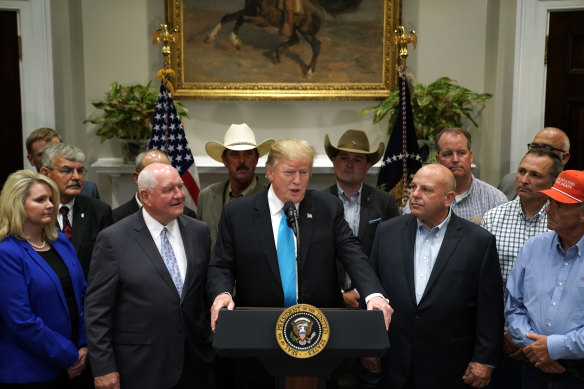
Trump talks about the trade war, flanked by farmers and ranchers, including one whose cap is emblazoned with Make Potatoes Great Again.Credit: Getty Images
What if the US and China strike a deal?
Following a striking escalation in trade tensions, Trump raised hopes of a resolution in late August when he said the US and China would resume talks “very shortly” and that “we’re in a stronger position now to do a deal”. Around the same time, China's top trade negotiator, Vice-Premier Liu He, used a public appearance in China to send a more conciliatory message.
“We are willing to solve the problem through consultation and cooperation with a calm attitude,” Liu was reported by Chinese media as saying on August 26. “We firmly oppose the escalation of the trade war.”
But Harcourt warns that a trade agreement between the world’s two biggest economies won’t necessarily be in Australia’s economic interests.
“Australia might be in a position where we don’t want it to all go really badly but we also don’t want it to go too well,” he said. “If Trump and [Chinese leader] Xi Jinping did a deal which resulted in a lot of managed trade, that could almost be worse. Then it becomes a world where big powerful players carve up key markets between themselves. We really don’t want that kind of sweetheart deal.”
Such a deal could mean Chinese buyers deliberately favoured US suppliers at the expense of exporters in other nations, including Australia. There has been speculation, for example, that Trump would push for export agreements for West Virginian coal to replace Australian coal.
Harcourt says the best case for Australia might be for China to back down on a few issues to give Trump a “symbolic win” that leaves the international trading system largely unchanged.
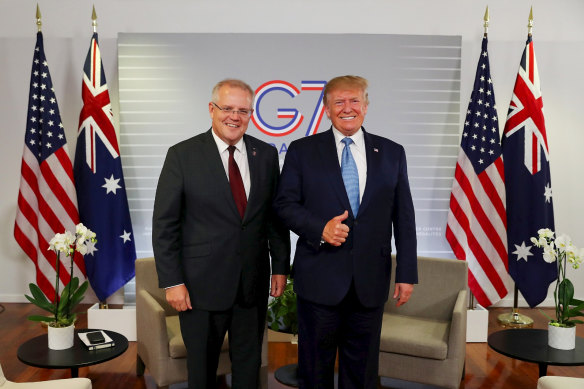
Scott Morrison meets Donald Trump at the G7 summit in Biarritz, France.
What should Australia do?
Prime Minister Scott Morrison acknowledges that the rules-based global trading system is under pressure and hopes the US and China come to an agreement “sooner rather than later”. But he says some US concerns are justified.
“Australia has always, and will continue to, welcome China’s economic growth,” Morrison said in a June speech. “However, the ground has now shifted. It is now evident that the US believes that the rules-based trading system in its current form is not capable of dealing with China’s economic structure and policy practices.
“Many of these concerns are legitimate. Forced technology transfer is unfair. Intellectual property theft cannot be justified. Industrial subsidies are promoting over-production.”
Morrison said Australia is committed to “open markets with trade relationships based on rules, not coercion”.
We should not just sit back and passively await our fate in the wake of a major power contest.
Prime Minister Scott Morrison in June
The chair of Australia’s Productivity Commission, Michael Brennan, says the “single most important” thing Australia can do in the face of mounting troubles in the world trading system is to keep our own borders open to trade and investment. Resurrecting trade barriers is not a solution, he argues.
But despite trade tensions and signs of growing protectionism there is still room for optimism. Harcourt is upbeat about Australia’s long-term trade prospects because of the opportunities presented by rapid economic change in Asia. Australia’s proximity means we’re well placed to benefit from demand for our goods and services as wealth in the region grows in coming decades. And two-thirds of Australia’s two-way trade is already with countries in Asia.
“All the things that Australia produces are in incredible demand in Asia so I wouldn't be too doom and gloom from an Australian point of view,” says Harcourt. “As our economic history shows, Australia’s path to prosperity depends on our success as a trading nation.”
Let us explain
If you'd like some expert background on an issue or a news event, drop us a line at explainers@smh.com.au or explainers@theage.com.au. Read more explainers here.